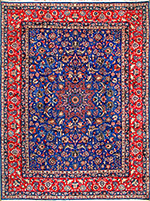Textiles Studies

Textile Research Works
Date of this Version
2022
Document Type
Article
Citation
Viana, V., Nagy, D., Xavier, J., Neiva, A., Ginoulhiac, M., Mateus, L. & Varela, P. (Eds.). (2022). Symmetry: Art and Science | 12th SISSymmetry Congress [Special Issue]. Symmetry: Art and Science. International Society for the Interdisciplinary Study of Symmetry. 168- 175. https://doi.org/10.24840/1447-607X/2022/12-21-168
Abstract
Symmetry is the organizing principle that underlies patternmaking in compound woven textiles of 17th century Iran. Persian velvets are particularly noteworthy for their complicated weave structure. What defines compound weaves is the interlacing of more than one set of warps (longitudinal elements held under tension at the loom) with wefts (transverse elements). Velvets introduce an additional set of supplementary warps held under differential tension. The weaving of a compound textile requires both a pattern harness and a structure harness for the interaction of warps and wefts. A weaver on the bench manipulates the structure harness for each passage of the weft introduced while weaving; a drawboy, positioned above the loom, manipulates the warps that are dressed upon the loom prior to weaving. The drawboy’s actions are guided by a naqsh, or maquette, affixed to the loom, which serves as the pattern harness. The role of the naqshbandi (literally, the one who ties the naqsh) cannot be underestimated in preparing the naqsh for Persian velvets and other compound weaves. The naqsh effectively programs the sequence of raising warps to create the shed for any given passage of the weft. The pattern repeat, established in the naqsh, is a technical unit that is technologically determined by the protocols of drawloom-weaving. Persian velvets of the 17th century typically represent three symmetry groups, reflecting the parameters of drawloom technology - periodicity (translation) of technical repeat units exhibit parallel glide reflections (pg) or reflections and parallel glide reflections across the warp axis (cm), or perpendicular reflections and glide reflections across both warp and weft axes (cmm).
Included in
Art and Materials Conservation Commons, Art Practice Commons, Fiber, Textile, and Weaving Arts Commons, Indigenous Studies Commons, Museum Studies Commons

